Att lysa i mörkret
Många organismer, både djur, växter och svampar, har förmågan att skapa och sända ut ljus från den egna kroppen. Detta kallas för bioluminiscens. Ljuset bildas med hjälp av egna enzymer och pigment som reagerar med syremolekyler, eller med hjälp av bakterier som alstrar ljus. I naturen används bioluminiscens på många olika sätt. Det är vanligast i haven, men förekommer även på land.
Djuphavsmarulken har ett lysande metspö i pannan, som lockar till sig bytesdjur i det mörka havet.
Bild: NOAA-Photo-Library-CC-BY
Bioluminiscens förekommer hos många varelser i haven. Bläckfiskar, maneter och räkor använder bioluminiscens för att kunna fly, skrämmas eller för att kommunicera med varandra.
Bild: Sierra-Blakely
Många arter av kammaneter är bioluminiscerande. På bilden syns arten Bathocyroe fosteri.
Djuphavsräkan Heterocarpus ensifer spyr ut bioluminiscerande vätska.
Bild: NOAA-Ocean-Explorer-CC-BY-SA
Även bakterier kan vara självlysande.
Bild: Rob-Cruickshank-CC-BY
Epålettsvampen lyser i mörkret.
Fisk med lysande metspö
Djuphavsmarulken lever på så stort djup att solljuset inte når ner. Den använder bioluminiscens för att söka mat. Djuphavsmarulken har en ombildad fena vid huvudet med en topp längst ut. I toppen lever bakterier som sänder ut ljus. Fenan fungerar som ett metspö, som lockar till sig fisk som djuphavsmarulken sedan slukar.

Bild: Frank.starmer-CC-BY
Skorpioners lysande skal
Nästan alla arter av skorpioner lyser på ett sätt som kallas flourescens. När skorpionens kropp tar emot UV-ljus, till exempel under fullmånenätter, absorberas UV-strålningen och skickas ut igen i form av ett blågrönt sken. Det blågröna ljuset är i en våglängd som vi människor kan se, till skillnad från UV. Forskarna har länge försökt ta reda på varför skorpioner lyser i mörkret. Ingen vet säkert, men troligtvis beror det på att skorpionen använder hela kroppen som ett stort öga. När ämnen i skorpionens skal reagerar med UV-ljuset vet skorpionen att den behöver vara försiktig och gömma sig.
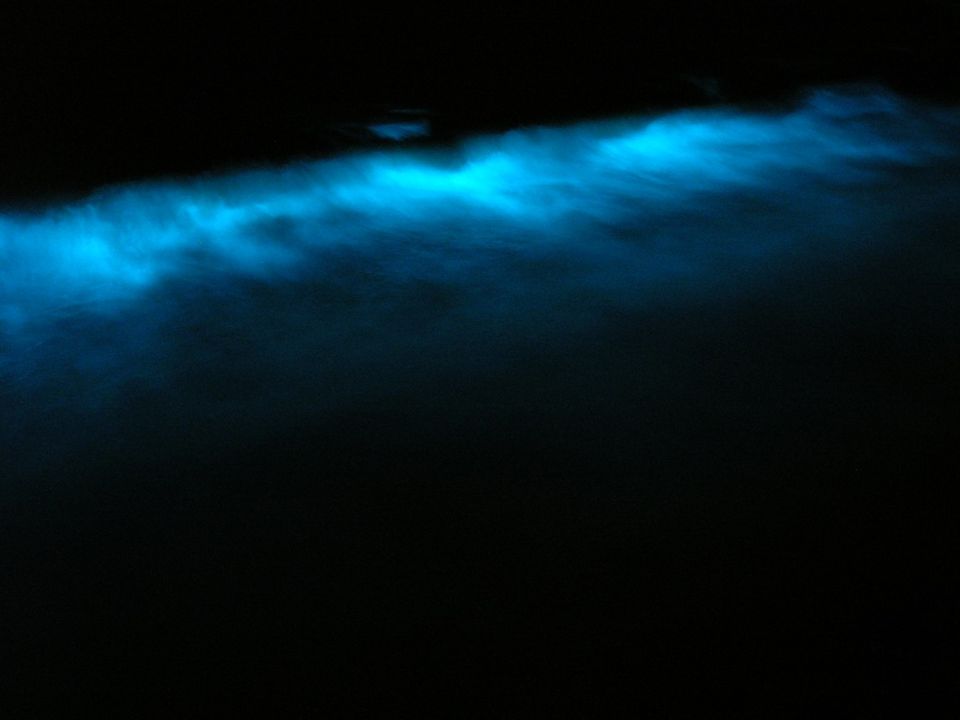
Bild: Jed-from-San-Diego-CC-BY-SA
Förvirrande ljusblixtar på natten
I slutet av sommaren kan man ibland se hur havsvattnet lyses upp av ett blågrönt sken. Det kallas för mareld. Marelden orsakas av växtplankton som är små encelliga alger. Eftersom växtplankton är föda åt många djur behöver de skydda sig. Genom att sända ut ljusblixtar försöker de förvirra eller skrämma bort angripare. Ljusblixtarna kan också locka till sig större fiskar som äter upp planktonätarna. I Sverige är mareld vanligast längs västkusten, men det förkommer även i Östersjön.
En eldfluga av arten Photinus pyralis.
Bild: art-farmer-CC-BY-SA
Arten större lysmask finns i Sverige.
Bild: Kadri-Niinsalu-CC-BY-SA
Eldflugor och lysmaskar
Eldflugan är egentligen en flygande skalbagge. Den sänder ut blinkande ljus när den flyger omkring på natten. Det är oftast hanen som blinkar. Blinkandet lockar till sig honor. Hos en del arter av eldflugor blinkar hanarna gemensamt i samma takt. Det gör dom för att honorna ska hitta rätt, och inte bli förvirrade av eldflugehanar av en annan art. Eldflugor finns inte i Sverige, men det gör i stället lysmaskar. Det är också är en lysande skalbagge. Det finns cirka 100 arter av lysmask runt om i världen. Två av dom finns i Sverige. Här är det honan som lyser. Hon kan inte flyga, utan sitter i gräs och på grenar och lyser med ett grönt sken. Honan kan lysa i flera timmar för att locka till sig hanar som hon kan para sig med. Men även hanarna och larverna lyser svagt. Det gröna ljuset signalerar också att lysmasken inte smakar gott och skrämmer bort djur som vill äta dom.

Vietnamesisk skogsskorpion
Heterometrus laoticus

Gift som studeras för medicin
Den vietnamesiska skogsskorpionen är en av världens största skorpionarter. Alla arter av skorpioner är giftiga, men det är verkligen inte alla som har ett gift som är farligt för människor. Ett stick från en vietnamesisk skogsskorpion är ungefär lika ofarligt som ett bistick. Men giftet från den vietnamesiska skogsskorpionen studeras av forskare, för att se om det innehåller ämnen som kan användas till mediciner.
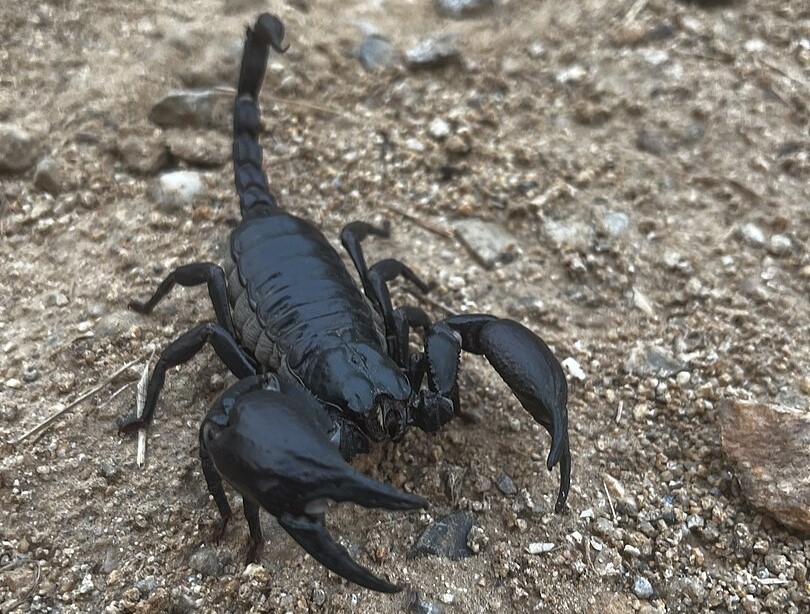
Bild: Nathan-Laurenz-CC-BY
Klarar sig på väldigt lite mat
I tropiska sumpiga skogsområden med mycket torv, lever den vietnamesiska skogsskorpionen. Den håller till på marken, gärna gömd under döda löv, grenar eller i hålor. Den är aktiv på natten. Då jagar den insekter eller andra småkryp att äta. Men en skorpion behöver äta mycket sällan – och skulle kunna klara sig på så lite som ett mål mat om året! Den vietnamesiska skogsskorpionen använder främst sina klor när den fångar ett byte, och behöver sedan öppna upp fångsten och suga i sig lite i taget av innehållet – eftersom den har en så liten mun.
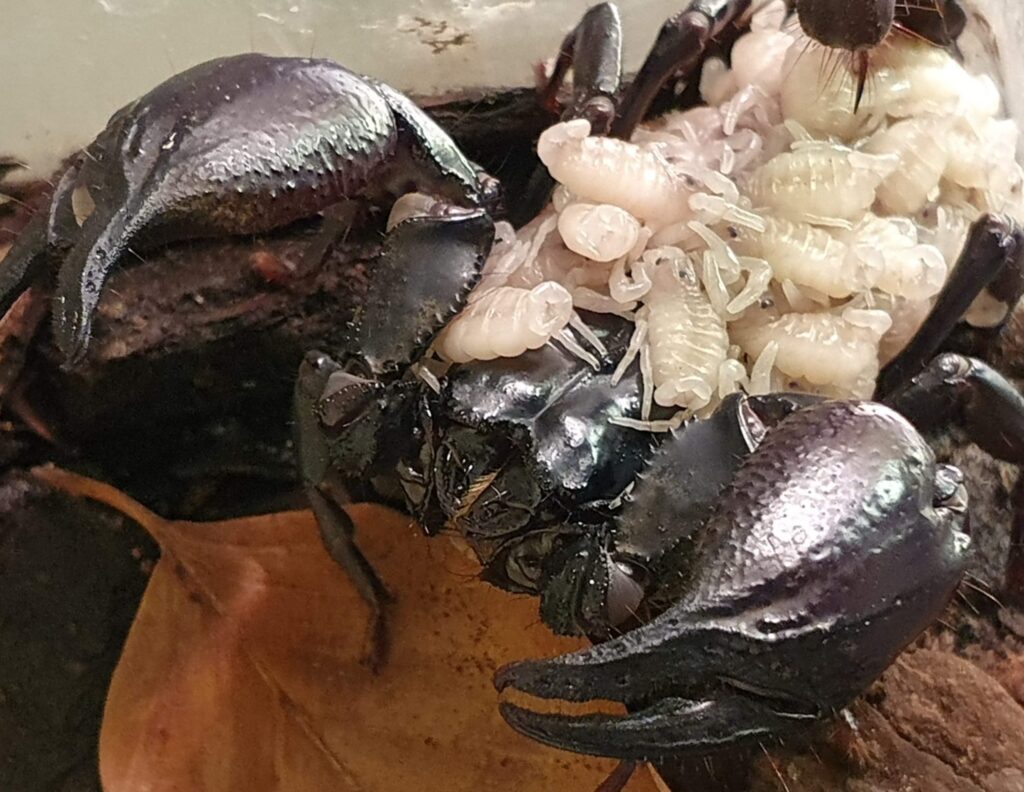
Bild: Ellika-Nordström-Malmö-Museum
Bär sina ungar på ryggen
Under parningstiden kan den vietnamesiska skogsskorpionen bli mycket aggressiv mot andra skorpioner av samma art. Det är hård konkurrens om honorna, och hanarna utför olika rörelser för att imponera på honan, och det kan till och med se ut som att de dansar hand i hand – genom att hålla varandra i klorna. Hanen lägger sedan ett slags paket på marken, som innehåller hans spermier. Han leder honan dit för att hon ska plocka upp paketet med sin könsöppning. Honans ägg befruktas och utvecklas i hennes kropp, och efter omkring ett halvår föder hon levande ungar! De första veckorna i livet lever ungarna på sin mammas rygg, tills de ömsat skal och klättrar ner.
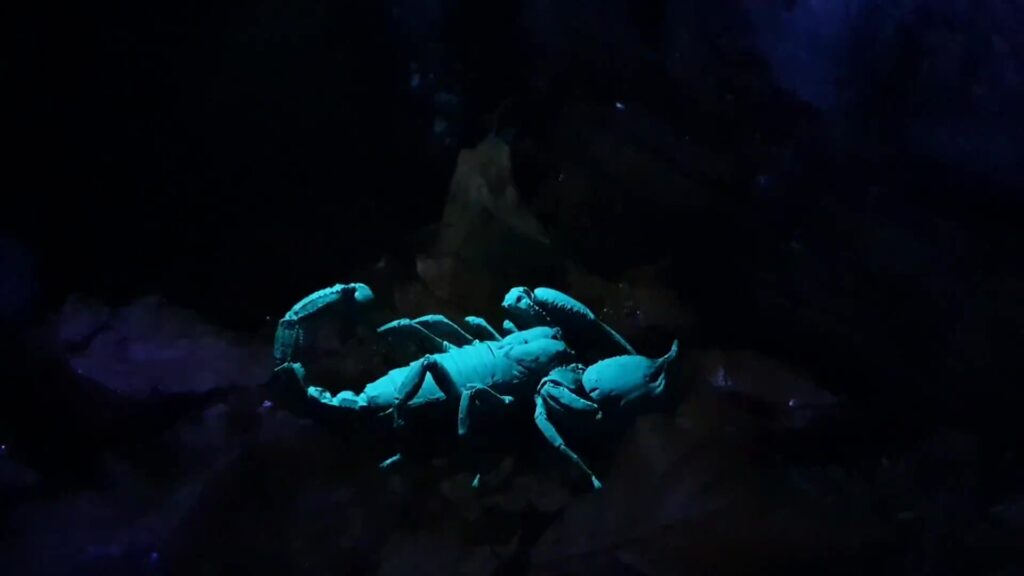
Bild: Ellika-Nordström-Malmö-Museum
Utbredningsområde i världen
Vietnam och Laos
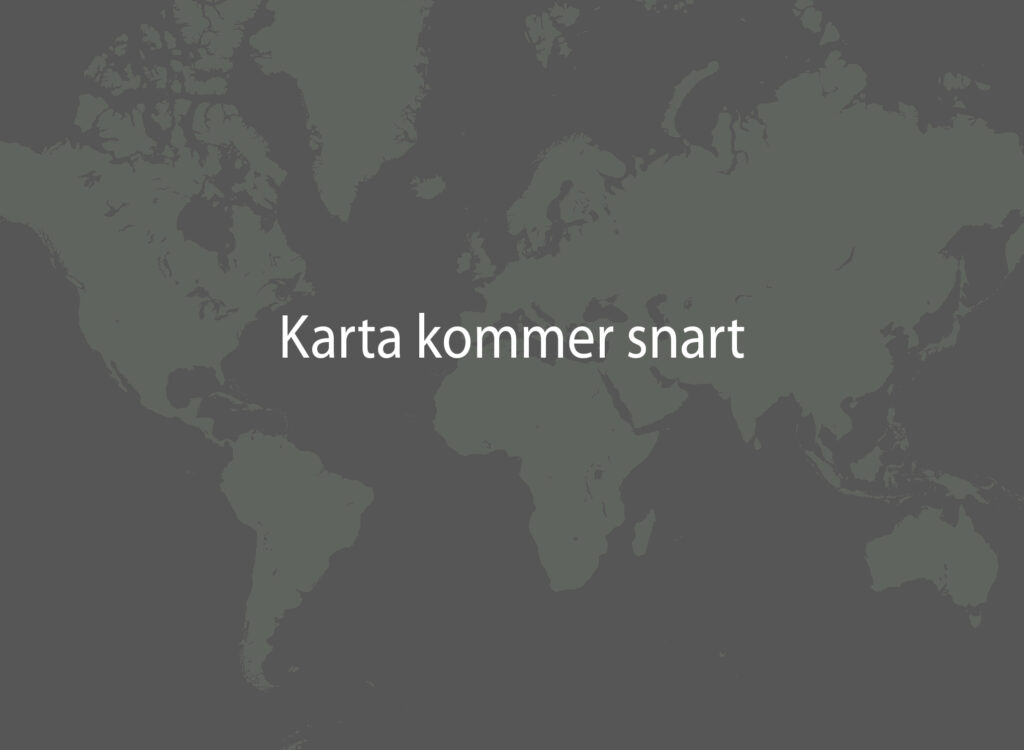
Hotstatus enligt Rödlistan

Reglerad inom handel
CITES: Ej listad.

Vad är Rödlistan?
Rödlistning är ett sätt att bedöma om olika djur- och växtarter är utrotningshotade utifrån kriterier som hur många djur eller växter som finns av arten och hur utbredda de är. En nationell rödlistning bedömer artens risk att dö ut inom ett lands gränser. Den internationella rödlistningen bedömer artens risk att dö ut över hela jorden.
Läs mer

Om rödlistning i Sverige: Artdatabanken, www.artdatabanken.se
Om rödlistning i världen: International Union for Conservation of Nature, IUCN, www.iucn.org

Vad är CITES?
För att bekämpa olaglig handel med djur och växter finns en internationell överenskommelse om handel, som heter CITES. CITES innebär att utrotningshotade djur och växter inte får köpas eller säljas mellan olika länder utan tillstånd.
CITES klassar olika arter i olika kategorier (som kallas Appendix I, II och III) beroende på hur hotad arten är. Ju större hotet från handeln är desto högre skydd. Inom EU finns ytterligare skydd för arter i CITES. EU:s egen klassning har fyra steg: A-D.
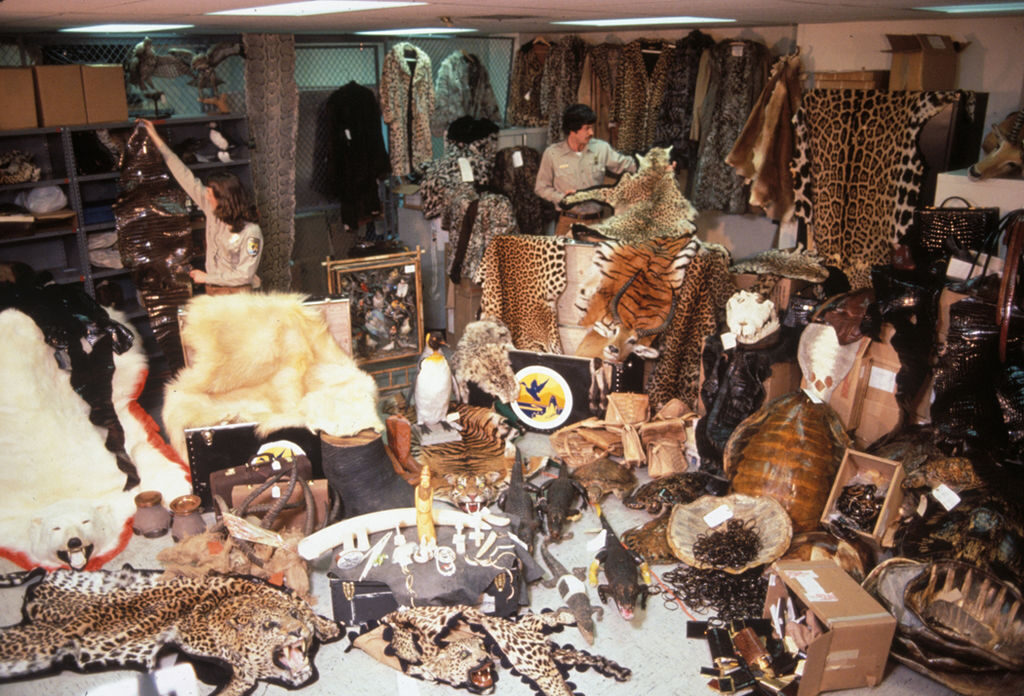
Bild: Steve-Hillebrand
Förbjudet att handla med viltfångade arter
Högst skydd mot handel har de arter som är inom kategori A och B. Här gäller oftast att handel mellan EU och övriga världen är förbjuden utan tillstånd. Arter som är CITES A eller B-klassade får inte heller köpas eller säljas inom EU om det inte kan bevisas att de har lagligt ursprung och inte fångats i det vilda.
Att använda växter eller djur för att tillverka souvenirer och annat är också förbjudet. Den som bryter mot reglerna kan dömas till böter eller fängelse.
Kontrollera spridning av arter
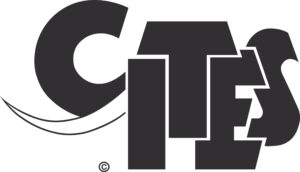
Arter som är CITES C-klassade är utrotningshotade i ett visst land men inte nödvändigtvis i hela världen. CITES D-klassning betyder att en art importeras i så stort antal att de behöver regleras för att inte riskera att sprida sig okontrollerat där de inte hör hemma.

To glow in the dark
Many organisms, including animals, plants and fungi, have the ability to create and emit light from their own bodies. This is called bioluminescence. The light is produced by their own enzymes and pigments reacting with oxygen molecules, or by bacteria generating light. In nature, bioluminescence is used in many different ways. It is most common in the oceans, but also occurs on land.
The deep sea angler fish has glowing fishing rod attached to its forehead. It lures prey, in the dark ocean, close to the angler fish's mouth.
Photo: NOAA-Photo-Library-CC-BY
Bioluminescence occurs in many species living in the ocean. Octopuses, squids, jellyfish and shrimp use bioluminescence to escape, intimidate, or to communicate with eachother.
Photo: Sierra-Blakely
Many species of comb jellies are bioluminescent. The photo shows the species Bathocyroe fosteri.
The deep sea shrimp Heterocarpus ensifer "vomits" bioluminescent fluid.
Photo: NOAA-Ocean-Explorer-CC-BY-SA
Bacteria can also glow in the dark.
Photo: Rob-Cruickshank-CC-BY
The bitter oyster fungus glows in the dark.
Fish with a glowing fishing rod
The deep-sea anglerfish lives at such great depths that sunlight cannot reach it. It uses bioluminescence to search for food. The deep-sea anglerfish has a modified fin at its head with a tip at the end. Bacteria that emit light live in the tip. The fin acts like a fishing rod, attracting fish which the deep-sea anglerfish then devours.

Photo: Frank.starmer-CC-BY
The glowing shell of scorpions
Almost all species of scorpions glow in a way called fluorescence. When the body of a scorpion receives UV light, for example during full moon nights, and the UV radiation is absorbed and re-emitted in the form of a blue-green glow. The blue-green light is at a wavelength that we humans can see, unlike UV. Scientists have long been trying to find out why scorpions glow in the dark. No one knows for sure, but it’s probably because the scorpion uses its whole body as one big eye. When substances in the scorpion’s shell react with the UV light, the scorpion knows it needs to be careful and hide.

Photo: Jed-from-San-Diego-CC-BY-SA
Confusing flashes of light at night
At the end of summer, you can sometimes see the water in the sea brighten up with a bluish green glow. This is known as the milky seas effect. The milky seas effect is caused by phytoplankton, which are small, single-celled algae. As phytoplankton are food for many animals, they need to protect themselves. By emitting flashes of light, they try to confuse or scare off attackers. The flashes can also attract larger fish that eat the plankton. In Sweden, the milky seas effect is most common along the west coast, but it also occurs in the Baltic Sea.
A fire beetle of the species Photinus pyralis.
Photo: art-farmer-CC-BY-SA
A species of firefly that may be found in Sweden.
Photo: Kadri-Niinsalu-CC-BY-SA
Fire beetles and fireflies
Despite its Swedish name (eldfluga), the fire beetle is actually, as the English name suggests, a flying beetle. It emits flashing lights as it flies around at night. It is usually the male that flashes. The flashing attracts females. In some species of fire beetles, the males flash together at the same rate. They do this so that the females can find their way around, and not be confused by male fire beetles of another species. Fire beetles are not found in Sweden, whereas fireflies are. This is, despite its name, another glowing beetle. There are about 100 species of fireflies around the world. Two of them can be found in Sweden. In this case it is the female that glows. She can’t fly, but sits in grass and on branches and radiates a green glow. The female can glow for several hours to attract males to mate with. But the males and larvae also glow dimly. The green light also signals that the firefly is not tasty and scares away animals that want to eat them.

Vietnamese Forest Scorpion
Heterometrus laoticus

Venom is being studied for medicine
The Vietnamese forest scorpion is one of the world’s largest scorpion species. All species of scorpions are venomous, but certainly not all have a venom that is dangerous to humans. A sting from a Vietnamese forest scorpion is about as harmless as a bee sting. But the venom of the Vietnamese forest scorpion is being studied by scientists to investigate if it contains substances that can be used for medicines.

Photo: Nathan-Laurenz-CC-BY
Survives on very little food
The Vietnamese forest scorpion lives in tropical swampy forestry areas with a lot of peat. It lives on the ground, preferably hidden under dead leaves, branches or in burrows. It is active at night. Then it hunts for insects or other small insects to eat. But a scorpion needs to eat very rarely – and could get by on as little as one meal a year! The Vietnamese forest scorpion mainly uses its claws when catching prey, and then needs to open up the catch and suck out the insides little by little – because it has such a small mouth.

Photo: Ellika-Nordström-Malmö-Museum
Carrying their offspring on their backs
During the mating season, the Vietnamese forest scorpion can become very aggressive towards other scorpions of the same species. There is fierce competition for the females, and the males perform various moves to impress the female; it can even look like they are dancing hand in hand – holding each other’s claws. The male then places a kind of package on the ground, which contains his sperm. He guides the female to the package and she picks it up with her genital opening. The female’s eggs are fertilised and developed in her body, and after about six months she gives birth to live offspring! For the first few weeks of life, the offspring live on their mother’s back, until they molt (shed their shells) and climb down.

Photo: Ellika-Nordström-Malmö-Museum
Distribution worldwide
Vietnam and Laos

Threat based on the Red List

Trade regulations
CITES: Not listed.

What is the Red List?
The Red List is a way to assess whether different animal and plant species are at risk of extinction based on criteria such as how many animals or plants of a species exist and how widely distributed they are. A national Red List assesses a species’ risk of dying out within national borders. The international Red List assesses a species’ risk of dying out worldwide.
Read more

About the Red List in Sweden: The Swedish Species Information Centre (Artdatabanken), www.artdatabanken.se/en/
About the Red List worldwide: The International Union for Conservation of Nature (IUCN), www.iucn.org

What is CITES?
CITES (the Convention on International Trade in Endangered Species of Wild Fauna and Flora) is a treaty that makes it illegal to buy or sell animals and plants that are at risk of extinction between countries without a permit.
CITES classifies species into different categories (called Appendix I, II and III) depending on how endangered each species is. In addition, the more the species is threatened by international trade, the higher its level of protection. Within the EU, CITES-listed species are further classified and protected by the EU’s own classification system. This has four Annexes, from A to D.

Photo: Steve-Hillebrand
Ban on trading wild-caught species
The highest protection against trade is given to CITES-listed species included in the EU’s Annexes A and B. Usually this means that trade between the EU and the rest of the world is illegal without a permit. There is also a ban on trading these species within the EU unless it can be proved that they have a lawful origin and were not caught in the wild.
It is also forbidden to use plants or animals to make souvenirs etc. Anyone who breaks these regulations can be fined or imprisoned.
Controlling the spread of species

CITES-listed species that are in the EU’s Annex C are classified as endangered in at least one country but not necessarily in the whole world. An Annex D classification means that individual members of a species may be imported to the extent that they do not need to be regulated to avoid any risk of them spreading uncontrollably where they do not belong.
